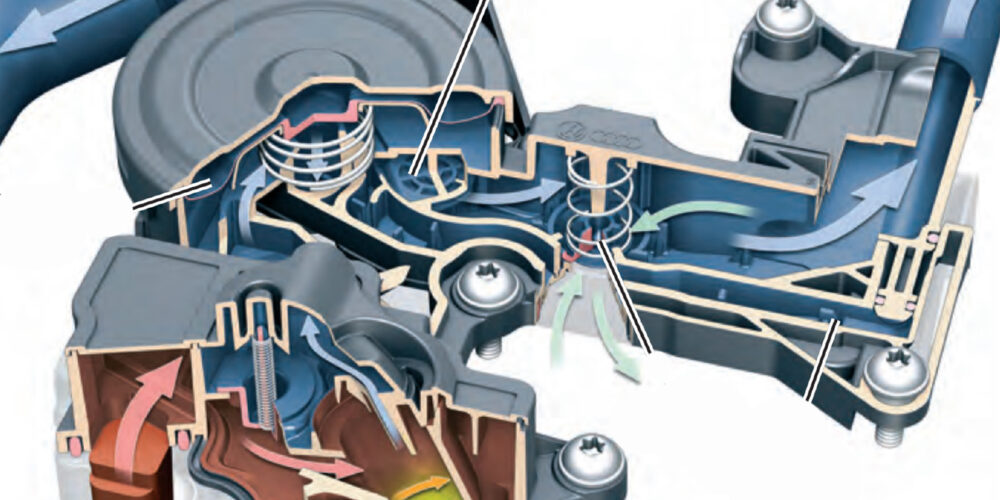MODELS:
2000-2011 GM Passenger Cars and Light Duty Trucks
CONDITION:
Some customers may comment on a tire that slowly loses air pressure over a period of days or weeks.
CAUSE:
 Abrasive elements in the environment may intrude between the tire and wheel at the bead seat. There is always some relative motion between the tire and wheel (when the vehicle is driven) and this motion may cause the abrasive particles to wear the wheel and tire materials.
Abrasive elements in the environment may intrude between the tire and wheel at the bead seat. There is always some relative motion between the tire and wheel (when the vehicle is driven) and this motion may cause the abrasive particles to wear the wheel and tire materials.
As the wear continues, there may also be intrusion at the tire/wheel interface by corrosive media from the environment. Eventually a path for air develops and a ‘slow’ leak may ensue. This corrosion may appear on the inboard or outboard bead seating surface of the wheel. This corrosion will not be visible until the tire is dismounted.
This bulletin specifically addresses issues related to wheel bead seat corrosion that may result in an air leak. For issues related to porosity of the wheel casting that may result in an air leak, refer to Corporate Bulletin Number 05-03-10-006F – Low Tire Pressure, Leaking Cast Aluminum Wheels (Repair with Adhesive Sealant).
CORRECTION:
In most cases, this type of air loss can be corrected by following the procedure below.
Important: DO NOT replace a wheel for slow air loss unless you have evaluated and/or tried to repair the wheel with the procedure below.
The repair is no longer advised or applicable for chromed aluminum wheels.
1. Remove the wheel and tire assembly for diagnosis. Refer to Tire and Wheel Removal and Installation in SI.
2. After a water dunk tank leak test, if you determine the source of the air leak to be around the bead seat of the wheel, dismount the tire to examine the bead seat. Shown below is a typical area of bead seat corrosion.Typical Location of Bead Seat Corrosion.

Note: Other forms of slow air leaks are possible. If the body of the tire, valve stem and wheel flange show no signs of air seepage, refer to Corporate Bulletin Number 05-03-10-003D for additional information on possible wheel porosity issues.
3. Bead seat corrosion is identified by what appears like blistering of the wheel finish, causing a rough or uneven surface that is difficult for the tire to maintain a proper seal on. To the right is a close-up photo of bead seat corrosion on an aluminum wheel that was sufficient to cause slow air loss.
 4. If corrosion is found on the wheel bead seat, measure the affected area as shown above.
4. If corrosion is found on the wheel bead seat, measure the affected area as shown above.
• For vehicles with 32,186 km (20,000 mi) or less, the total allowable combined linear area of repairable corrosion is 100 mm (4 in) or less. If the total area(s) of corrosion exceed these dimensions, the wheel should be replaced.
• For vehicles that have exceeded 32,186 km (20,000 mi), the total allowable combined linear area of repairable corrosion is 200 mm (8 in) or less. If the total area(s) of corrosion exceed these dimensions, the wheel should be replaced.
 5. In order to correct the wheel leak, use a clean-up (fine cut) sanding disc or biscuit to remove the corrosion and any flaking paint.
5. In order to correct the wheel leak, use a clean-up (fine cut) sanding disc or biscuit to remove the corrosion and any flaking paint.
You should remove the corrosion back far enough until you reach material that is stable and firmly bonded to the wheel. Try to taper the edge of any flaking paint as best you can in order to avoid sharp edges that may increase the chance of a leak reoccurring. The photo above shows an acceptable repaired surface.
Corrosion that extends up the lip of the wheel, where after the clean-up process it would be visible with the tire mounted, is only acceptable on the inboard flange. The inboard flange is not visible with the wheel assembly in the mounted position. If any loose coatings or corrosion extend to the visible surfaces on the FACE of the wheel, that wheel must be replaced.
Remove ONLY the material required to eliminate the corrosion from the bead seating surface. DO NOT remove excessive amounts of material. ALWAYS keep the sealing surface as smooth and level as possible.
6. Once the corrosion has been eliminated, you should coat the repaired area with a commercially available tire sealant such as Patch Brand Bead Sealant or equivalent. Commercially available bead sealants are black rubber-like coatings that will permanently fill and seal the resurfaced bead seat. At 21°C (70°F) ambient temperature, this sealant will set-up sufficiently for tire mounting in about 10 minutes.
7. Remount the tire and install the repaired wheel and tire assembly.
Courtesy of ALLDATA.









